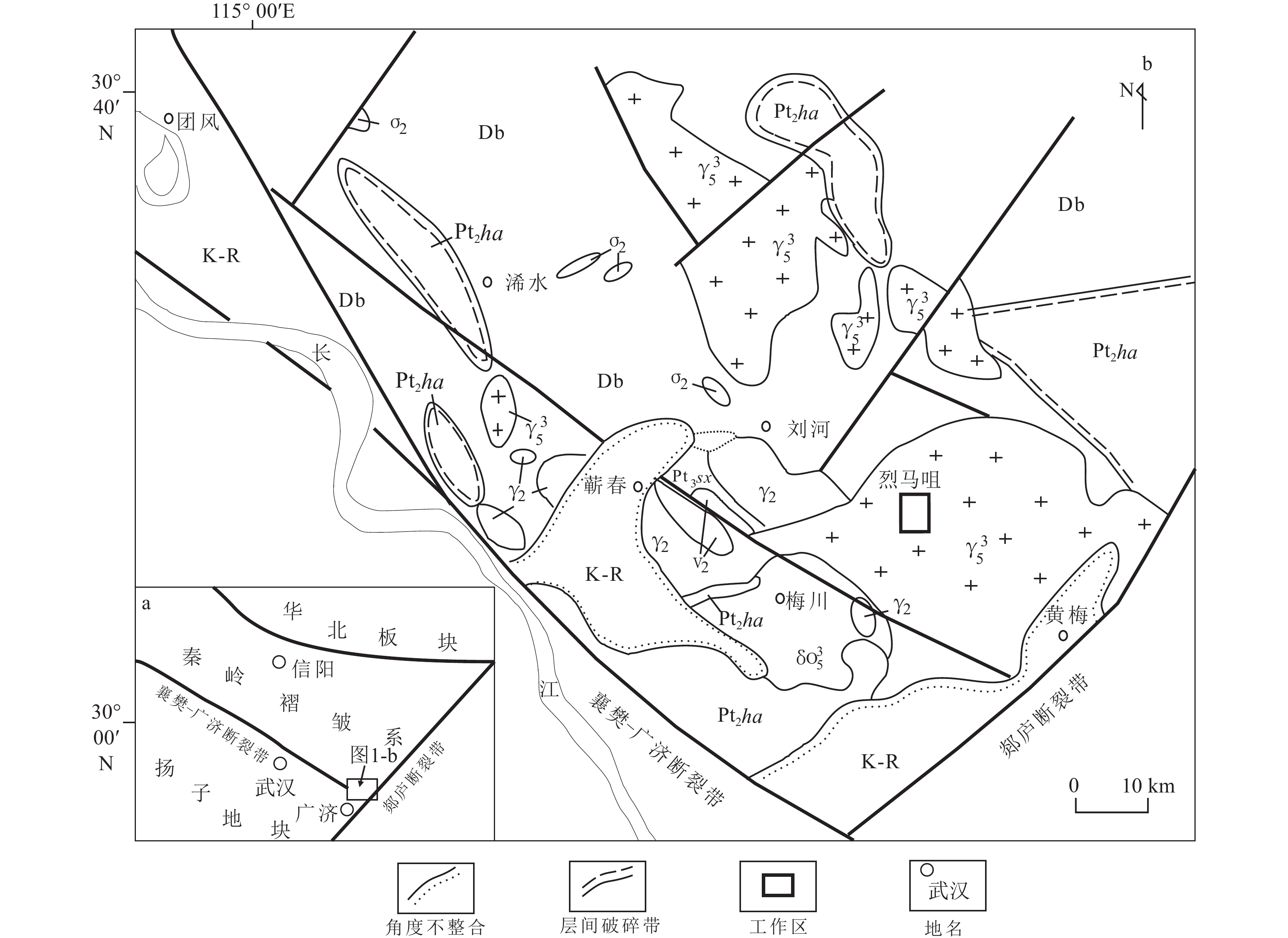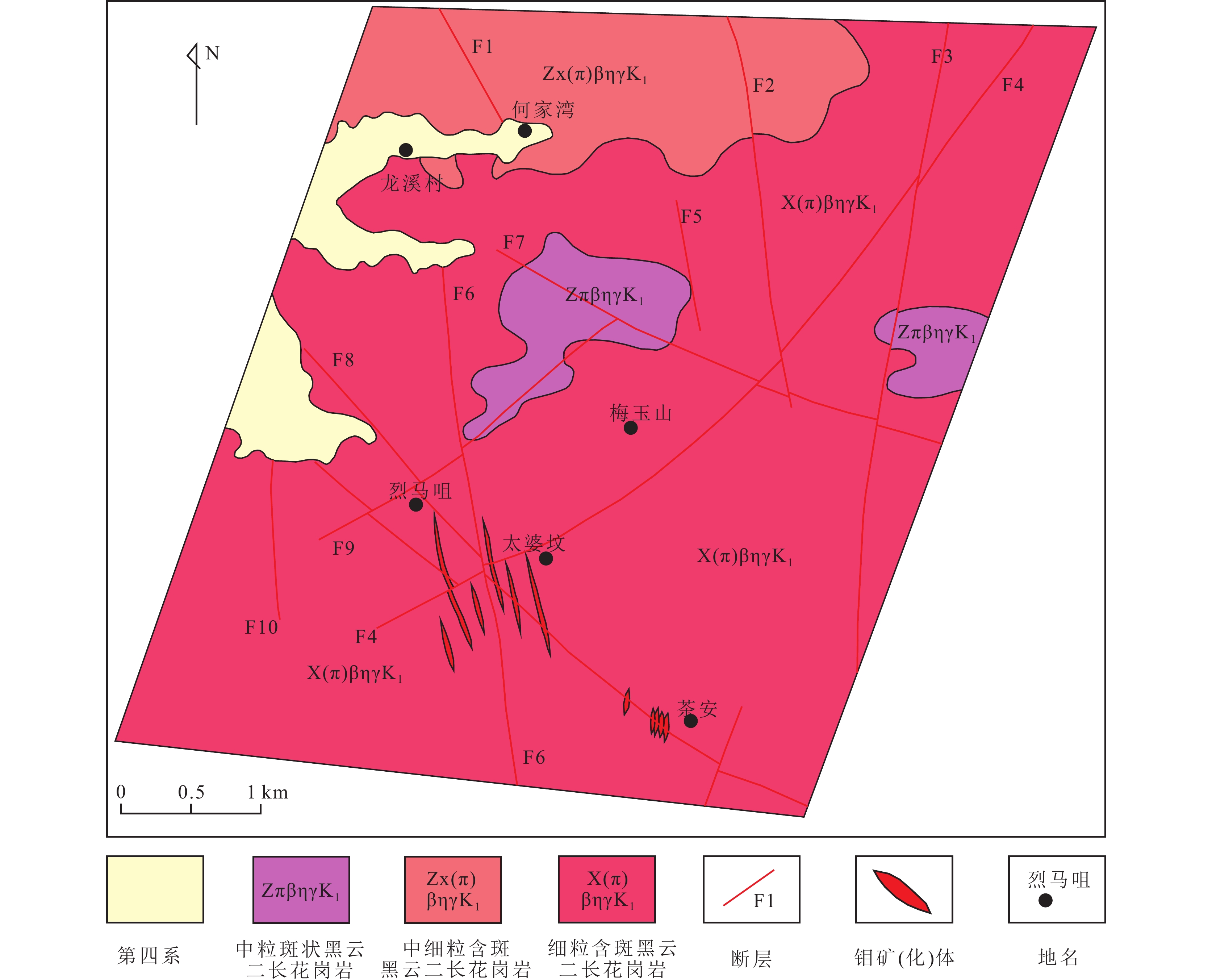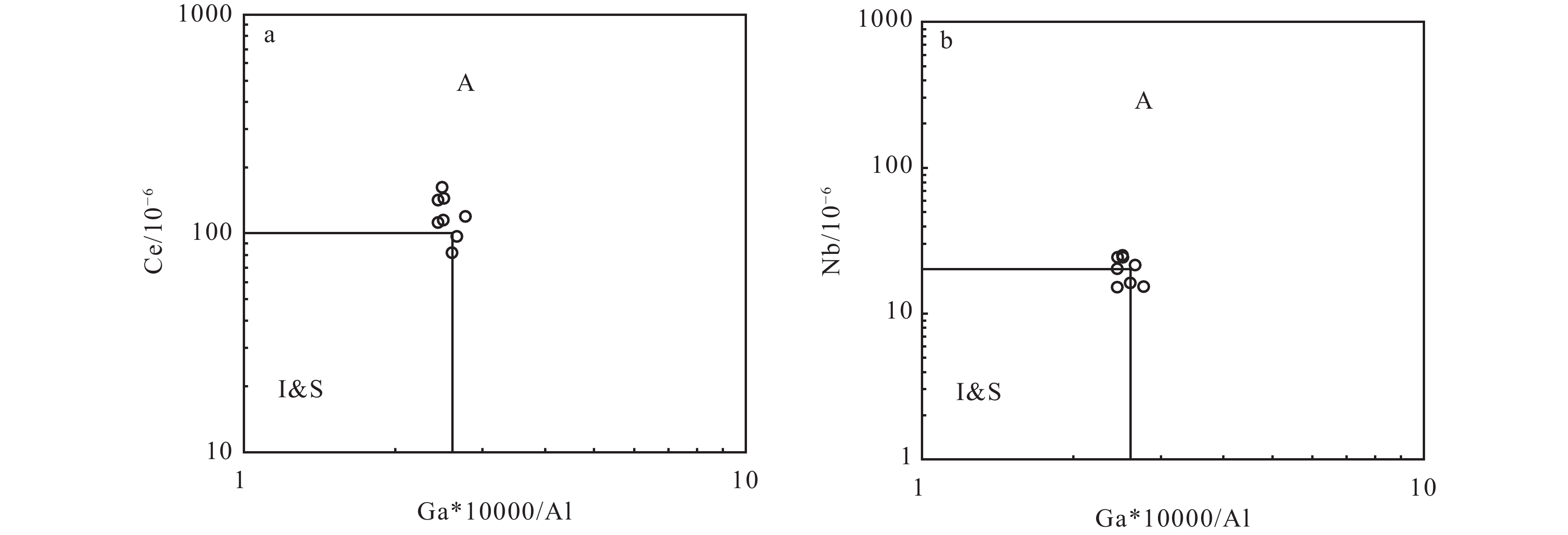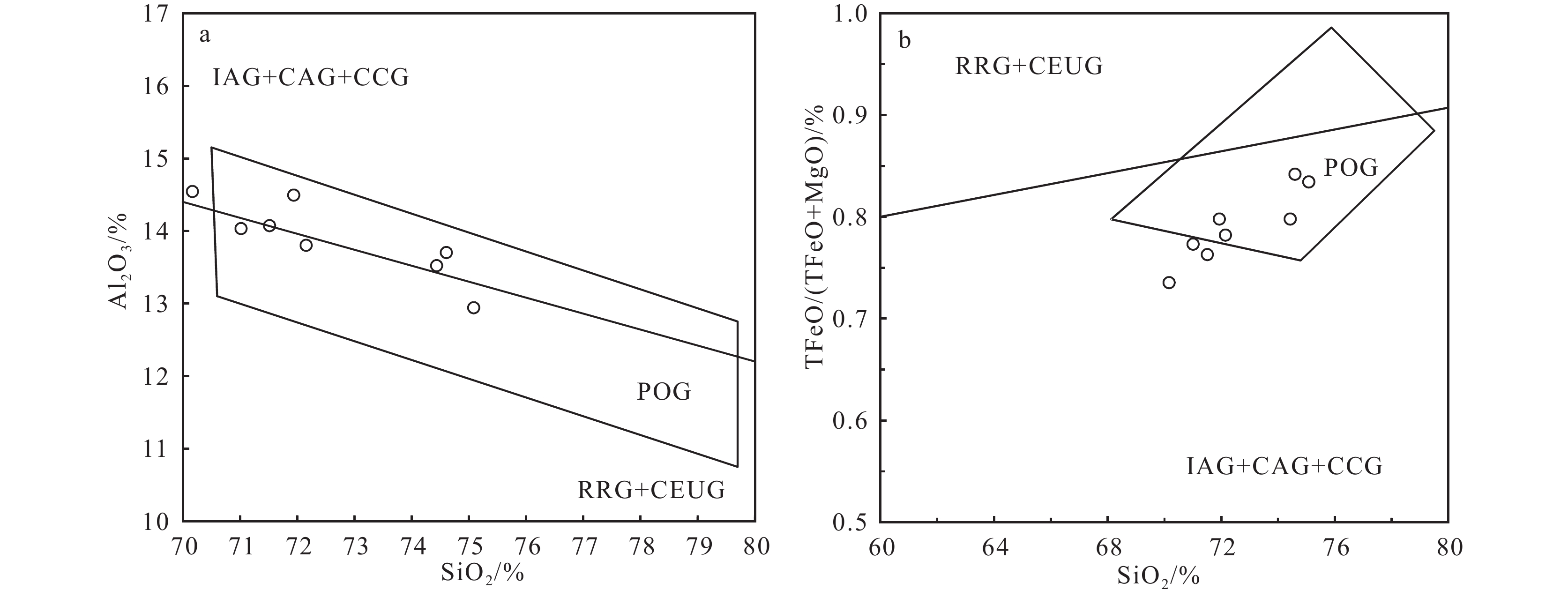The genesis of Qichun liemazui granite and its relationship with molybdenum mineralization
-
摘要:
湖北蕲春烈马咀钼矿位于大别山南坡,已探明的大型钼矿鲜有报道,对该矿区的深入研究甚少,缺少对成岩成矿时代、成因和构造背景的准确厘定。对烈马咀钼矿及与成矿有关的花岗岩进行了岩相学、岩石地球化学研究和Re−Os同位素测年。结果表明:与成矿有关的岩石为斑状二长花岗岩或二长花岗斑岩,矿区成矿规模小,矿石为浸染状或细脉浸染状展布;辉钼矿等时线年龄为119±8 Ma,年龄加权平均值为118.9±0.98 Ma,指示烈马咀钼矿为早白垩世热液产物;岩石地球化学数据表明其为高硅、高钾钙碱性系列A型花岗岩;稀土元素的总含量高,轻稀土元素含量相对富集,重稀土元素含量相对亏损。烈马咀钼矿区与成矿有关的岩石形成于大别造山带伸展环境,与燕山晚期岩石圈减薄有关。
-
关键词:
- 烈马咀花岗岩 /
- 辉钼矿 /
- 岩石地球化学 /
- Re−Os同位素测年 /
- 湖北
Abstract:Qichun Liemazui molybdenum mine in Hubei Province is located on the southern slope of Dabie Mountain. Proven large molybdenum mines are rarely reported. There are few in−depth studies on this mining area, and there is a lack of accurate determination of the diagenetic and mineralization age, genesis and tectonic setting. In this paper, the Liemazui ore−forming granite was selected for petrographic, and petrochemical studies. The experimental results indicate that the ore−forming rocks are porphyry monzogranite or monzogranite−porphyry by petrographic analysis. The ore−forming scale of the mining area is small. The ore is disseminated or veined disseminated. The isochronous age of molybdenite in liemazui deposit is 119±8 Ma, the weighted mean age was 118.9±0.98 Ma. Therefore, the Liemazui molybdenum deposit is formed in the Early Cretaceous. Geochemical data show that it is a high−silicon, high−potassium, calc−alkaline series A−type granite. The total amount of rare earth elements is high, the light rare earth elements are enriched, and the heavy rare earth elements are relatively deficient. The rocks related to metallogenic formation in the Liemazui molybdenum mining area were formed in the extensional environment of the Dabie orogenic belt, and were related to the thinning of the lithosphere in the Late Yanshanian period.
-
Key words:
- Liemazui granite /
- molybdenite /
- petrochemical /
- Re−Os isotopic dating /
- Hubei Provincce
-

-
图 1 区域大地构造图(a)和矿区区域地质图(b)(据马元等,2013修改)
Figure 1.
图 2 矿区地质图(据周文平等,2013 修改)
Figure 2.
图 5 SiO2−K2O图解(a,实线据Peccerillo,1976修改;虚线据Middlemost,1985修改)和A/CNK−A/NK图解(b)
Figure 5.
图 6 稀土元素球粒陨石标准化分布型式(a)和微量元素原始地幔标准化蛛网图(b)(球粒陨石和原始地幔标准化数据据Sun et al.,1989)
Figure 6.
图 8 岩石成因判别图解(底图据Whalen et al.,1987)
Figure 8.
图 9 构造判别图解(底图据Maniar et al.,1989)
Figure 9.
表 1 蕲春烈马咀花岗岩主量、微量和稀土元素分析结果
Table 1. Major, trace and rare earth elements content of Qichun Liemazui granite
元素 Qc-4 Qc-6 Qc-8 Qc-10 Qc-11 Qc-14 Qc-15 Qc-16 斑状花岗岩 花岗斑岩 斑状花岗岩 花岗斑岩 花岗岩 花岗斑岩 花岗斑岩 花岗斑岩 SiO2 75.09 74.44 71.02 71.94 72.16 71.52 74.61 70.17 TiO2 0.14 0.2 0.38 0.26 0.29 0.36 0.14 0.45 Al2O3 12.94 13.52 14.03 14.49 13.8 14.07 13.7 14.54 MnO 0.04 0.04 0.04 0.04 0.05 0.04 0.04 0.05 MgO 0.24 0.34 0.64 0.5 0.53 0.68 0.22 0.95 CaO 0.95 1.16 1.12 1.54 1.38 1.67 1.08 2 Na2O 3.73 3.59 3.76 3.58 3.59 3.78 3.74 3.94 K2O 4.83 5.05 4.96 5.23 5.14 4.81 4.95 4.43 P2O5 0.04 0.06 0.14 0.08 0.11 0.14 0.04 0.19 Fe2O3 1.34 1.49 2.42 2.19 2.11 2.43 1.3 2.93 TFe 0.94 1.04 1.69 1.53 1.48 1.70 0.91 2.05 K2O/Na2O 1.29 1.41 1.32 1.46 1.43 1.27 1.32 1.12 Na2O+K2O 8.56 8.64 8.72 8.81 8.73 8.59 8.69 8.37 A/NK 1.51 1.56 1.61 1.64 1.58 1.64 1.58 1.74 A/CNK 0.98 1 1.03 1 0.99 0.97 1.02 0.98 δ 2.28 2.37 2.71 2.68 2.61 2.59 2.39 2.58 Li 11.89 26.84 15.62 25.27 22.71 19.80 21.51 17.79 Be 4.05 3.87 2.63 3.01 3.42 3.71 4.04 2.59 Sc 2.55 3.20 4.11 3.18 3.69 3.98 2.88 4.47 V 7.12 12.91 24.59 17.87 19.24 25.54 7.58 33.73 Cr 2.37 3.55 9.92 6.80 10.97 10.85 2.71 15.06 Co 21.35 52.73 46.01 59.48 79.75 50.56 48.58 42.48 Ni 1.36 1.99 5.97 3.99 6.83 5.90 2.06 8.75 Cu 21.99 2.83 3.34 1.35 4.37 3.02 8.81 10.78 Zn 29.09 29.52 29.74 38.84 41.30 36.46 30.85 47.31 Ga 18.89 18.94 18.48 18.83 18.31 18.79 18.93 18.51 Rb 205.23 176.71 124.83 160.07 170.24 156.26 199.18 112.26 Sr 203.21 236.63 423.42 287.98 306.05 357.66 159.62 513.27 Y 24.83 19.95 26.01 16.26 22.74 23.19 10.33 24.69 Zr 178.77 157.68 259.26 240.31 177.23 188.98 151.38 186.52 Nb 15.48 21.61 23.88 15.06 24.83 23.98 16.12 23.33 Mo 0.97 0.42 0.37 0.86 0.28 0.44 6.47 0.46 Sn 2.65 2.34 2.02 1.62 2.08 1.95 1.16 1.82 Cs 1.39 1.14 1.02 0.59 0.94 0.69 1.11 0.54 Ba 892.89 900.81 1514.25 1669.08 1251.73 1183.29 800.45 1549.87 La 66.38 56.01 88.22 81.74 61.18 74.73 48.58 76.54 Ce 120.11 96.71 162.06 139.30 114.44 140.59 81.34 146.19 Pr 12.18 9.52 16.29 13.95 12.38 14.53 8.05 15.51 Nd 40.96 30.90 56.13 45.51 42.50 50.19 25.78 53.58 Sm 7.11 4.74 8.73 6.90 6.87 7.63 3.65 8.43 Eu 0.93 0.83 1.64 1.33 1.25 1.37 0.72 1.69 Gd 5.43 3.63 6.41 5.08 5.19 5.63 2.56 6.38 Tb 0.76 0.51 0.88 0.66 0.73 0.77 0.32 0.85 Dy 4.12 3.01 4.62 3.32 3.89 4.05 1.60 4.46 Ho 0.73 0.56 0.85 0.55 0.73 0.76 0.29 0.82 Er 2.10 1.77 2.31 1.44 2.10 2.17 0.86 2.31 Tm 0.32 0.29 0.34 0.19 0.31 0.32 0.14 0.32 Yb 2.21 2.06 2.37 1.25 2.04 2.13 1.02 2.17 Lu 0.34 0.35 0.35 0.21 0.32 0.33 0.19 0.32 Hf 5.37 5.09 6.45 6.19 4.97 5.52 4.67 4.87 Ta 1.69 1.99 1.94 1.03 2.12 1.77 1.22 1.61 Tl 1.21 0.97 0.65 0.81 0.88 0.85 1.07 0.58 Pb 49.92 38.84 30.74 33.84 35.08 30.14 44.38 25.42 Th 29.62 24.88 19.47 24.89 18.36 20.85 24.08 17.63 U 3.57 5.65 1.98 3.17 2.98 4.11 3.34 2.21 δEu 0.46 0.61 0.67 0.69 0.64 0.64 0.72 0.67 δNd 4.25 4.33 4.49 4.37 4.41 4.53 4.40 4.48 δSr 1.77 2.41 5.61 3.27 3.17 3.99 1.52 7.50 (La/Yb)N 21.59 19.53 26.66 47.00 21.52 25.23 34.13 28.11 (Sr/Y)N 8.18 11.86 16.28 17.71 13.46 15.43 15.44 15.43 LREE/HREE 6.06 6.18 7.55 9.97 6.27 7.35 9.71 7.13 ΣREE 288.52 230.85 377.22 317.70 276.67 328.39 185.43 344.26 注:主量元素含量单位为%,微量和稀土元素含量单位为10−6 表 2 湖北蕲春烈马咀辉钼矿Re−Os同位素数据
Table 2. Re−Os isotopic data for molybdenite from the Hubei Qichun Liemazui Mo deposit
样号 样重/g Re/10−6 普Os/10−6 187Re/10−6 187Os/10−9 模式年龄/Ma 测定值 不确定度 测定值 不确定度 测定值 不确定度 测定值 不确定度 测定值 不确定度 HM-07 0.05001 12.20 0.09 0.000 0.010 7.667 0.059 15.39 0.18 120.3 1.9 HM-06 0.05000 12.62 0.18 0.004 0.014 7.934 0.112 15.58 0.14 117.8 2.2 HM-08 0.05014 13.40 0.29 0.004 0.019 8.425 0.183 16.47 0.14 117.3 2.9 HM-09 0.05016 21.92 0.41 0.004 0.011 13.77 0.26 27.31 0.22 118.9 2.6 HM-10 0.04999 19.38 0.24 0.025 0.012 12.18 0.15 24.19 0.20 119.1 2.0 表 3 蕲春花岗岩与国内外各类花岗岩主量元素及部分微量元素含量对比(据吴锁平等,2007修改)
Table 3. Statistical comparison of major elements and some trace elements between Qichun granite and various granites at home and abroad
元素 世界花岗岩平均 中国花岗岩平均 蕲春 A型(148) M型(17) I型(991) S型(578) A型(197) M型(4) I型(62) S型(26) A型 SiO2 73.81 67.24 69.17 70.27 73.55 75.35 64.52 73.35 72.62 Al2O3 12.4 15.18 14.33 14.1 12.81 12.09 15.83 13.89 13.89 Fe2O3 1.24 1.94 1.04 0.56 1.42 0.93 1.25 0.81 2.03 CaO 0.75 4.27 3.2 2.03 0.82 1.97 3.98 1.17 1.36 MgO 0.2 1.73 1.42 1.42 0.27 0.18 1.98 0.32 0.51 Na2O 4.07 3.97 3.13 2.41 3.76 5.19 3.65 3.3 3.71 K2O 4.65 1.26 3.4 3.96 4.69 0.51 3 4.79 4.93 MnO 0.06 0.11 0.07 0.06 0.09 0.06 0.1 0.04 0.04 TiO2 0.26 0.49 0.43 0.48 0.23 0.18 0.59 0.19 0.28 P2O5 0.04 0.09 0.11 0.15 0.07 0.06 0.18 0.11 0.10 元素 A 型( 148) M 型( 17) I 型( 991) S 型( 578) A 型( 140) M 型( 4) I 型( 28) S 型( 11) A型 Ba 352 263 538 466 235.96 277 988.28 664.18 1218.80 Rb 169 17.5 151 217 269.69 8 119.42 227.08 163.10 Sr 48 282 247 120 57.54 62.3 469.94 156.65 311.0 Nb 37 1.3 1 12 34.93 4.07 11.4 14.14 20.60 Zr 528 108 151 165 333.77 111 148.32 114.2 191.40 Y 75 22 28 32 54.03 43.4 19.32 17.31 20.10 Ga 24.6 15 16 17 18.54 4.54 18.80 Ga/Al 3.75 1.87 2.28 2.25 2.60 Rb/Sr 3.52 0.06 0.61 1.81 20.58 4.69 0.21 1.55 0.70 Rb/Ba 0.48 0.07 0.28 0.47 8.94 1.14 0.09 0.46 0.20 注:主量元素含量单位为%,微量元素含量单位为10−6 表 4 蕲春花岗岩与国内各类型花岗岩稀土元素平均含量对比(据吴锁平等,2007修改)
Table 4. Comparison of average content of rare earth elements between Qichun granite and various types of domestic granites
10−6 类型 La Ce Pr Nd Sm Eu Gd Tb A(88) 18.40 144.12 119.47 85.41 58.94 12.23 38.70 40.72 I(11) 118.62 79.259 53.17 43.82 25.39 16.32 14.08 9.50 S(20) 177.71 133.30 97.99 58.16 38.16 12.77 20.16 17.60 蕲春 70.00 126.10 12.90 43.40 6.80 1.20 5.00 0.70 类型 Dy Ho Er Tm Yb Lu ΣREE Eu A(88) 29.32 30.16 30.34 36.21 31.95 33.17 29.32 30.16 I(11) 7.915 5.61 6.09 6.32 6.05 5.68 7.92 5.62 S(20) 13.96 14.16 13.38 14.69 11.37 12.21 13.96 14.17 蕲春 3.60 0.70 7.02 0.30 1.90 0.30 293.63 1.20 -
[1] Bureau of Geology and Mineral Resources of Hubei Province. 1990. Regional Geological Records of Hubei Province[M]. Geology Press (in Chinese with English abstract).
[2] Chen L, Ma C Q, Zhang J Y M, et al. 2012. The first geological map of intrusive rocks in Dabie orogenic belt and its adjacent areas and its explanatory notes[J]. Geological Bulletin of China, 31(1): 13−18 (in Chinese with English abstract).
[3] Chen W, Zhou W P, Chen K X, et al. 2014. Re−Os isotopic dating on molybdenite and its geological signficance from the Baiyashan molybdenum deposit in Machen City, Hubei Province[J]. Resources Environment & Engineering, 28(6): 781−785 (in Chinese with English abstract).
[4] Chen Y J, Wang P, Li N, et al. 2017. The collision−type porphyry Mo deposits in Dabie Shan, China[J]. Ore Geology Reviews, 81(2): 405−430.
[5] Du A D, He H L, Yin N, et al. 1994. A study on the Re−Os geochro−nometry of molybdenites[J]. Acta Geologica Sinica, 4: 339−347 (in Chinese with English abstract).
[6] Du D W, Hong H L, Fan K, et al. 2012. Characteristics of molybdenum polymetallic soil anomalies and ore−prospecting prospects in limazui, Qichun County, Hubei Province[EB/OL](2012-05-31)[2020-01-12]. http://www.paper.edu.cn (in Chinese with English abstract).
[7] Du D W, Hong H L, Fan K, et al. 2013. Study on the fine structure of K−Feldspar of Qichun granite[J]. Spectroscopy and Spectral Analysis, 33(3): 613−617 (in Chinese with English abstract).
[8] Fan H, Wang D, Santosh M, et al. 2014. Genesis of the Yuanlingzhai porphyry molybdenum deposit, Jiangxi Province, South China: Constraints from petrochemistry and geochronology[J]. Journal of Asian Earth Sciences, 79(pt.B): 759−776.
[9] Fu Z G, Jin Y H, Wu F, et al. 2007. Geological characteristics of host rocks of 5 mega Mo deposits in East Qinling−Dabie[J]. Contributions to Geology and Minerel Resources Research, 22(4): 277−281 (in Chinese with English abstract).
[10] Gong Y J, Jiang Z, Chen D M, et al. 2017. Re−Os isotopic ages of Limuling molybdenum deposit in southern Dabie Mountain and their geological significance[J]. Mineral Deposits, 36(4): 992−1002 (in Chinese with English abstract) .
[11] Guo H, Liu H X, Wang R H, et al. 2002. Characteristics of Mesozoic tectonic evolution in the Dabie Mountains orogenic belt[J]. Uranium Geology, (6): 321−327 (in Chinese with English abstract).
[12] Hao J, Liu X H. 2003. Discovery of eclogites in the Qichun areas in the southernslope of the Dabie Mountains and some related problems[J]. Geological Bulletin of China, 22(10): 798−802 (in Chinese with English abstract).
[13] Huang F, Wang D H, Lu S M, et al. 2011. Molybdenite Re−Os isotopic age of Shapinggou Mo deposit in Anhui Province and Mesozoic Mo ore−forming stages in East Qinling−Dabie Mountain region[J]. Mineral Deposits, 30(6): 1039−1057(in Chinese with English abstract).
[14] Jian W, Liu W, Shi L H. 2010. Advances in study of porphyry molybdenum deposits[J]. Mineral Deposits, 29(2): 308−316 (in Chinese with English abstract).
[15] Jiang T, Qiu X F, Lu S S. 2019. Petrogenesis of the Qijianfeng granite in southern Tongbai−Dabie orogenic belt: Constraints from geochemistry, zircon U−Pb age and Hf isotope[J]. Geology in China, 47(4): 1109−1126 (in Chinese with English abstract).
[16] Li J P, Li Y F, Luo Z Z, et al. 2011. Geological features of molybdenum deposits and ore prospecting in Northern Slope of the Dabie Mountain, China[J]. Geotectonica et Metallogenia, 35(4): 576−586. (in Chinese with English abstract).
[17] Liu C, Guochunzhao, Liu F. 2020. Coexistence of A− and I−type granites in the Lüliang Complex: Tectonic implications for the middle Paleoproterozoic Trans North China Orogen, North China Craton[J]. Lithos, 380/381: 105875.
[18] Liu Q Q, Liu Y H, Li Y F, et al. 2013. Metallogenic conditions and genesis of porphyry molybdenum deposit in the northern piedmont of Dabieshan Mountain[J]. Contributions to Geography and Mineral Resources Research, 28(1): 27−33 (in Chinese with English abstract).
[19] Liu X. 2013. Geochemical characteristics and their indication for molybdenum mineralization of the Cretaceous granite at Hubei, Qichun[D]. China University of Geosciences(Wuhan)(in Chinese with English abstract).
[20] Liu X, Wu Y, Jin S H. 2021. U−Pb zircon age of Lianhuashan pluton in the junction of Anhui−Zhejiang−Jiangxi Province: Geological Implication[J]. Geology and Resources, 30(6): 666−674 (in Chinese with English abstract).
[21] Lu X X, Li M L, Wei X D, et al. 2006. Geological geochemistry characteristics of porphyry molybdenum deposits in East Qin Mountains[J]. Geology of Yunnan, 4: 415−417 (in Chinese with English abstract).
[22] Lu X X, Luo Z H, Huang F, et al. 2009. Study on the relationship between Qin Mountains−Dabie Mountains granites and molybdenum deposits[J]. Acta Mineralogica Sinica, A1: 445−446 (in Chinese with English abstract) .
[23] Lu X X, Luo Z H, Huang F, et al. 2011. Mo deposit types and mineralization assemblage characteristics in Qinling−Dabie Mountain area[J]. Geology in China, 38(6): 1518−1535 (in Chinese with English abstract).
[24] Luo Y N, Chen J W, Wang Y, et al. 2016. Tectonomagmatic activity and Mo metallogeny in the Qinling−Dabie Orogenic Belt[J]. Acta Geologica Sichuan, 36(2): 234−238,257. (in Chinese with English abstract).
[25] Luo Z Z, Li Y F, Wang Y T, et al. 2010. The molybdenite Re−Os age of Dayinjian molybdenum deposit in the northern margin of the Dabie Mountain, Xinxian area, Henan, China and its significance[J]. Geological Bulletin of China, 29(9): 1349−1354 (in Chinese with English abstract).
[26] Luo Z Z. 2010. Metallogenic regularity and prospecting direction of Mo−Au−Ag polymetallic deposit of north piedmont of Dabieshan[J]. Mineral Resources and Geology, 24(2): 125−131 (in Chinese with English abstract).
[27] Ma C Q, Yang K G, Ming H L, et al. 2003. Mesozoic crust transition from compression to extension in Dabie Mountains: Evidence from granite[J]. Science in China (Ser.D), 33(9): 817−827(in Chinese with English abstract) .
[28] Ma Y, Sun S Q, Wu C X, et al. 2013. Zircon U−Pb ages and petro−geochemistry of Liemazui granite, Qichuan County, Huibei Province, China[J]. Acta Mineralogica Sinica, 33(4): 698−704 (in Chinese with English abstract).
[29] Maniar P D, Piccoli P M. 1989. Tectonic discrimination of granitoids[J]. Geological Society of America Bulletin, 101(5): 635−643. doi: 10.1130/0016-7606(1989)101<0635:TDOG>2.3.CO;2
[30] Mao J W, Zhang Z H. 1999. Re−Os age dating of molybdenites in the Xiaoliugou tungsten deposit in the Northern Qlilian moutains and its signifcance[J]. Geological Review, 45(4): 412−417 (in Chinese with English abstract).
[31] Mao J W, Pirajno F, Xiang J F, et al. 2011. Mesozoic molybdenum deposits in the east Qinling–Dabie orogenic belt: Characteristics and tectonic settings[J]. Ore Geology Reviews, 43(1): 264−293. doi: 10.1016/j.oregeorev.2011.07.009
[32] Mao J W, Xie G Q, Bierlein F, et al. 2008. Tectonic implications from Re–Os dating of Mesozoic molybdenum deposits in the East Qinling–Dabie orogenic belt[J]. Geochimica et Cosmochimica Acta, 72(18): 4607−4626. doi: 10.1016/j.gca.2008.06.027
[33] Middlemost E A K. 1985. Magmas and magmatic rocks: An introduction to igneous petrology[M]. Longman, DOI:10.1180/minmag.1986.050. 355.34.
[34] Ni P, Wang G G, Yu W, et al. 2015. Evidence of fluid inclusions for two stages of fluid boiling in the formation of the giant Shapinggou porphyry Mo deposit, Dabie Orogen, Central China[J]. Ore Geology Reviews, 65(4): 1078−1094.
[35] Peccerillo A, Taylor S R. 1976. Geochemistry of eocene calc−alkaline volcanic rocks from the Kastamonu area, Northern Turkey[J]. Contributions to Mineralogy & Petrology, 58(1): 63−81.
[36] Qu W J, Du A D. 2003. Highly Precise Re−Os dating of molybdenite by ICP−MS with Carius Tube sample digestion[J]. Rock and Mineral Analysis, 22(4): 254−257 (in Chinese with English abstract).
[37] Rudnick R L, Fountain D M. 1995. Nature and composition of the continental crust: a lower crustal perspective[J]. Reviews of Geophysics, 33(3): 267−309. doi: 10.1029/95RG01302
[38] Sirisokha S, Yonezu K, Tindell T, et al. 2019. Lithogeochemistry of intrusive rocks in the Halo porphyry copper−molybdenum prospect, Northeast Cambodia[J]. Open Journal of Geology, 9(7): 342−363. doi: 10.4236/ojg.2019.97023
[39] Smoliar M I, Walker R J, Morgan J W. 1996. Re−Os ages of group IIA, IIIA, IVA and VIB iron meteorites[J]. Science, 271: 1099−1102. doi: 10.1126/science.271.5252.1099
[40] Sun S S, McDonough W F. 1989. Chemical and isotopic systematics of oceanic basalts: Implications for mantle composition and processes[J]. Geological Society London Special Publications, 42(1): 313−345. doi: 10.1144/GSL.SP.1989.042.01.19
[41] Trevor H. Green. 1995. Significance of Nb/Ta as an indicator of geochemical processes in the crust−mantle system[J]. Chemical Geology, 120: 347−359. doi: 10.1016/0009-2541(94)00145-X
[42] Whalen J B, Currie K L, Chappell B W. 1987. A−type granites: geochemical characteristics, discrimination and petrogenesis[J]. Contributions to Mineralogy & Petrology, 95(4): 407−419.
[43] Wu S P, Wang M Y, Qi K J. 2007. Present situation of researches on A−type granites: A review[J]. Acta Petrological et Mineralogica, 26(1): 57−66 (in Chinese with English abstract).
[44] Wu F Y, Li X H, Yang J H et al. 2007. Discussions on the petrogenesis of granites[J]. Acta Petrologica sinica, 23(6): 1217−1238 (in Chinese with English abstract).
[45] Ye X F, Zong K Q, Zhang Z M. 2013. Geochemistry of Neoproterozoic granite in Liuyuan area of southern Beishan orogenic belt and its geological significance[J]. Geological Bulletin of China, (C1): 307−317 (in Chinese with English abstract).
[46] Ye X F, Cai L Y, Tu J H. 2014. Discussion on comprehensive prospecting information in Liemazui mining area, Qichun County, Hubei Province[J]. West−China Exploration Engineering, 26(12): 151−155(in Chinese with English abstract).
[47] Yang M Z, Zeng J N, Qi Y J, et al. 2010. LA−ICP−MS zircon U−Pb and molybdenite Re−Os dating for Qian'echong porphyry−type Mo deposit in Northern Dabie, China, and its geological significance[J]. Geological Science and Technology Information, 29(5): 35−45 (in Chinese with English abstract).
[48] Yang Z Q, Tang X W. 2015. Geochemical characteristics and zircon LA−ICP−MS U−Pb isotopic dating of the Xiaofan rock bodies in North Dabieshan[J]. Acta Geologica Sinica, 89(4): 692−700 (in Chinese with English abstract).
[49] Zhang C, Ma C Q. 2008. Large−scale Late Mesozoic magmatism in the Dabie moutain: Constraints from zircon U−Pb and Hf isotopes[J]. Mineralogy and Petrology, 28(4): 71−79(in Chinese with English abstract).
[50] Zhang S, Liu C, Ju N, et al. 2021. Geochemistry and provenance sandstone from Yaojia formation in central depression, Southern Songliao Basin[J]. Geology and Resources, 30(5): 544−554 (in Chinese with English abstract).
[51] Zhong S Y, Yang C, Li S T, et al. 2020. Zircon U−Pb geochronology and geochemical characteristics of Taiyangnao rock mass in Qichun[J]. Resources Environment & Engineering, (34): 8−15,77 (in Chinese with English abstract).
[52] Zhou W P, Ye X F, Teng X Q. 2013. Research of relationship between country rock alteration and mineralization in Liemazui molybdenum deposit, Qichun County[J]. Resources Environment & Engineering, 27(5): 714−719 (in Chinese with English abstract).
[53] 陈玲, 马昌前, 张金阳, 等. 2012. 首编大别造山带侵入岩地质图(1∶50万)及其说明[J]. 地质通报, 31(1): 13−18. doi: 10.3969/j.issn.1671-2552.2012.01.002
[54] 陈炜, 周文平, 陈开旭, 等. 2014. 湖北麻城白鸭山钼矿床辉钼矿Re−Os同位素年龄测定及其地质意义[J]. 资源环境与工程, 28(6): 781−785. doi: 10.3969/j.issn.1671-1211.2014.06.003
[55] 杜安道, 何红蓼, 殷宁, 等. 1994. 辉钼矿的铼−锇同位素地质年龄测定方法研究[J]. 地质学报, 4: 339−347. doi: 10.3321/j.issn:0001-5717.1994.04.005
[56] 杜登文, 洪汉烈, 范坎, 等. 2012. 湖北省蕲春县烈马咀钼多金属土壤异常特征及找矿前景探讨[EB/OL]. (2012-05-31)[2020-01-12]. http:// www.paper.edu.cn.
[57] 杜登文, 洪汉烈, 范坎, 等. 2013. 湖北蕲春花岗岩钾长石的结构状态研究[J]. 光谱学与光谱分析, 33(3): 613−617. doi: 10.3964/j.issn.1000-0593(2013)03-0613-05
[58] 付治国, 靳拥护, 吴飞, 等. 2007. 东秦岭—大别山5个特大型钼矿床的成矿母岩地质特征分析[J]. 地质找矿论丛, 22(4): 277−281. doi: 10.3969/j.issn.1001-1412.2007.04.007
[59] 郭华, 刘红旭, 王润红, 等. 2002. 大别山造山带中生代构造演化特 征[J]. 铀矿地质, (6): 321−327. doi: 10.3969/j.issn.1000-0658.2002.06.001
[60] 龚银杰, 江朱, 陈冬明, 等. 2017. 大别山南麓梨木岭钼矿床辉钼矿Re−Os同位素年龄及地质意义[J]. 矿床地质, 36(4): 992−1002.
[61] 郝杰, 刘小汉. 2003. 大别山南坡蕲春等地榴辉岩的发现及相关问题[J]. 地质通报, 22(10): 798−802. doi: 10.3969/j.issn.1671-2552.2003.10.008
[62] 湖北省地质矿产局. 1990. 湖北省区域地质志[M]. 北京: 地质出版社.
[63] 黄凡, 王登红, 陆三明, 等. 2011. 安徽省金寨县沙坪沟钼矿辉钼矿Re−Os年龄——兼论东秦岭−大别山中生代钼成矿作用期次划 分[J]. 矿床地质, 30(6): 1039−1057. doi: 10.3969/j.issn.0258-7106.2011.06.005
[64] 简伟, 柳维, 石黎红. 2010. 斑岩型钼矿床研究进展[J]. 矿床地质, 29(2): 308−316. doi: 10.3969/j.issn.0258-7106.2010.02.012
[65] 江拓, 邱啸飞, 卢山松, 等. 2019. 桐柏—大别造山带南缘七尖峰花岗岩成因: 来自地球化学、锆石U−Pb年代学和Hf同位素的制约[J]. 中国地质, 47(4): 1109−1126.
[66] 李俊平, 李永峰, 罗正传, 等. 2011. 大别山北麓钼矿找矿重大进展及其矿床地质特征研究[J]. 大地构造与成矿学, 35(4): 576−586. doi: 10.3969/j.issn.1001-1552.2011.04.011
[67] 刘清泉, 柳玉虎, 李永峰, 等. 2013. 大别山北麓斑岩型钼矿床成矿地质条件及矿床成因[J]. 地质找矿论丛, 28(1): 27−33. doi: 10.6053/j.issn.1001-1412.2013.01.004
[68] 刘欣. 2013. 湖北蕲春白垩纪花岗岩地球化学及对钼成矿作用的指 示[D]. 中国地质大学(武汉)硕士学位论文.
[69] 刘欣, 伍月, 金珊合. 2021. 皖浙赣交界莲花山岩体U−Pb锆石年龄及其地质意义[J]. 地质与资源, 30(6): 666−674.
[70] 卢欣祥, 李明立, 尉向东, 等. 2006. 东秦岭斑岩型钼矿地质地球化学特征[J]. 云南地质, 4: 415−417. doi: 10.3969/j.issn.1004-1885.2006.04.025
[71] 卢欣祥, 罗照华, 黄凡, 等. 2009. 秦岭—大别山花岗岩与钼矿的关系研究[J]. 矿物学报, A1: 445−446. doi: 10.3321/j.issn:1000-4734.2009.z1.234
[72] 卢欣祥, 罗照华, 黄凡, 等. 2011. 秦岭—大别山地区钼矿类型与矿化组合特征[J]. 中国地质, 38(6): 1518−1535. doi: 10.3969/j.issn.1000-3657.2011.06.012
[73] 骆亚南, 陈加伟, 王勇, 等. 2016. 秦岭大别造山构造岩浆活动与钼成矿规律[J]. 四川地质学报, 36(2): 234−238,257. doi: 10.3969/j.issn.1006-0995.2016.02.013
[74] 罗正传, 李永峰, 王义天, 等. 2010. 大别山北麓河南新县地区大银尖钼矿床辉钼矿Re−Os同位素年龄及其意义[J]. 地质通报, 29(9): 1349−1354. doi: 10.3969/j.issn.1671-2552.2010.09.011
[75] 罗正传. 2010. 大别山北麓钼金银多金属矿成矿规律及找矿方向[J]. 矿产与地质, 24(2): 125−131. doi: 10.3969/j.issn.1001-5663.2010.02.005
[76] 马昌前, 杨坤光, 明厚利, 等. 2003. 大别山中生代地壳从挤压转向伸展的时间: 花岗岩的证据[J]. 中国科学(D辑), 33(9): 817−827. doi: 10.3321/j.issn:1006-9267.2003.09.001
[77] 马元, 孙四权, 吴昌雄, 等. 2013. 湖北蕲春烈马咀花岗岩锆石U−Pb年龄和岩石地球化学特征[J]. 矿物学报, 33(4): 698−704.
[78] 毛景文, 张作衡. 1999. 北祁连山小柳沟钨矿床中辉相矿Re−Os年龄测定及其意义[J]. 地质论评, 45(4): 412−417. doi: 10.3321/j.issn:0371-5736.1999.04.012
[79] 屈文俊, 杜安道. 2003. 高温密闭溶样电感耦合等离子体质谱准确测定辉钼矿铼-锇地质年龄[J]. 岩矿测试, 22(4): 254−257,262. doi: 10.3969/j.issn.0254-5357.2003.04.003
[80] 吴福元, 李献华, 杨进辉, 等. 2007. 花岗岩成因研究的若干问题[J]. 岩石学报, 23(6): 1217−1238. doi: 10.3969/j.issn.1000-0569.2007.06.001
[81] 吴锁平, 王梅英, 戚开静. 2007. A型花岗岩研究现状及其述评[J]. 岩石矿物学杂志, 26(1): 57−66. doi: 10.3969/j.issn.1000-6524.2007.01.009
[82] 叶晓峰, 宗克清, 张泽明, 等. 2013. 北山造山带南缘柳园地区新元古代花岗岩的地球化学特征及其地质意义[J]. 地质通报, (C1): 307−317. doi: 10.3969/j.issn.1671-2552.2013.02.010
[83] 叶学峰, 蔡立元, 屠江海. 2014. 湖北省蕲春县烈马咀矿区综合找矿信息探讨[J]. 西部探矿工程, 26(12): 151−155. doi: 10.3969/j.issn.1004-5716.2014.12.050
[84] 杨梅珍, 曾键年, 覃永军, 等. 2010. 大别山北缘千鹅冲斑岩型钼矿床锆石U−Pb和辉钼矿Re−Os年代学及其地质意义[J]. 地质科技情报, 29(5): 35−45.
[85] 杨泽强, 唐相伟. 2015. 北大别山肖畈岩体地球化学特征和锆石LA−ICP−MS U−Pb同位素定年[J]. 地质学报, 89(4): 692−700. doi: 10.3969/j.issn.0001-5717.2015.04.003
[86] 张超, 马昌前. 2008. 大别山晚中生代巨量岩浆活动的启动: 花岗岩锆石U−Pb年龄和Hf同位素制约[J]. 矿物岩石, 28(4): 71−79. doi: 10.3969/j.issn.1001-6872.2008.04.013
[87] 张森, 刘超, 鞠楠, 等. 2021. 松辽盆地南部中央凹陷区姚家组砂岩地球化学特征及沉积物源[J]. 地质与资源, 30(5): 544−554.
[88] 钟石玉, 杨成, 李书涛, 等. 2020. 蕲春太阳脑岩体锆石U−Pb年代学及岩石地球化学特征研究[J]. 资源环境与工程, (34): 8−15,77.
[89] 周文平, 叶学峰, 滕雪琴. 2013. 蕲春县烈马咀钼矿围岩蚀变与成矿关系探讨[J]. 资源环境与工程, 27(5): 714−719. doi: 10.3969/j.issn.1671-1211.2013.05.024
-




 下载:
下载:







